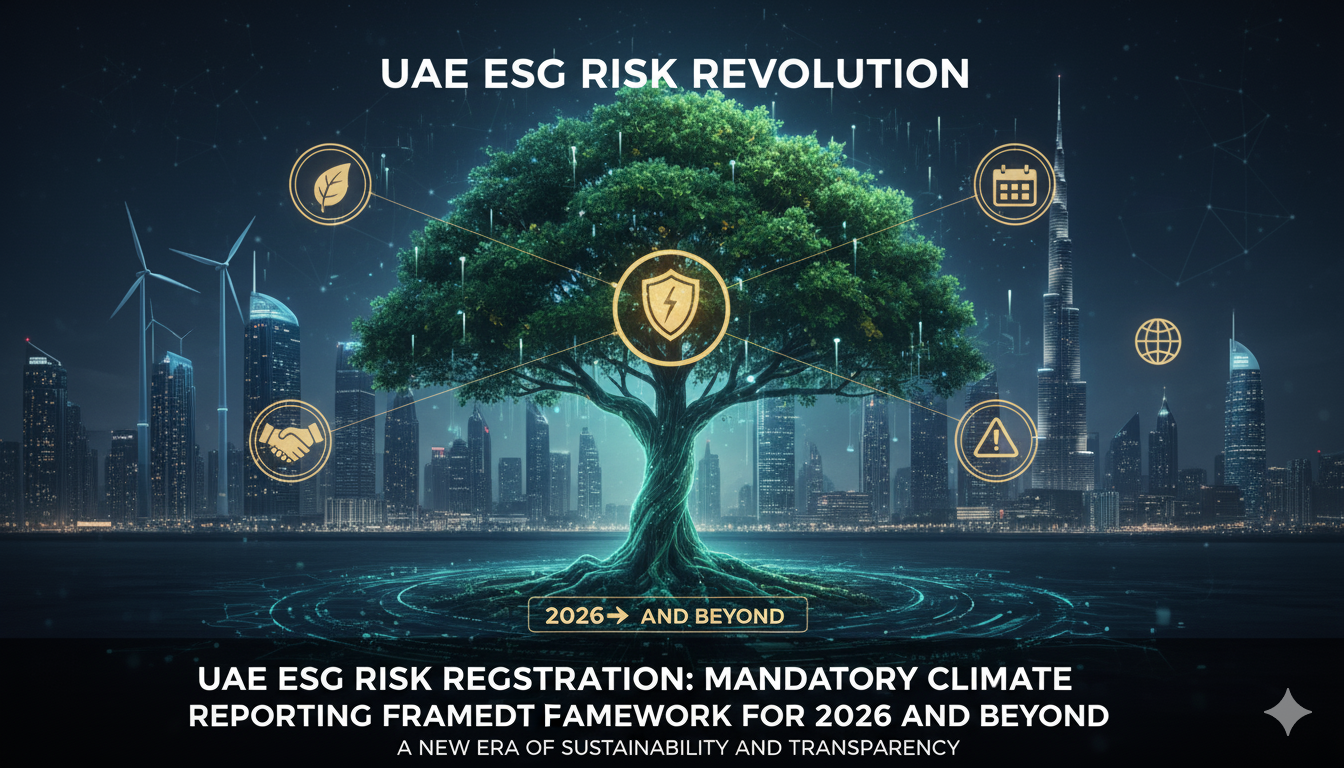➤ Introduction: 2026 Ushers in a New ESG Compliance Era
The UAE has shifted from voluntary sustainability to mandatory environmental accountability through Federal Decree-Law No. 11 of 2024 on the Reduction of Climate Change Effects, effective May 30, 2025, with full compliance due by May 30, 2026.
For the first time, all entities—across public, private, and free zone jurisdictions—must disclose direct and indirect emissions, register climate data, and submit verified reduction strategies through MOCCAE’s national platform.
This law makes ESG obligations as critical as financial reporting, positioning climate compliance and risk management at the heart of board oversight.
➤ Scope and Core Requirements
Coverage
All UAE entities, irrespective of size or licensing authority, must:
- Measure and report Scope 1 (direct emissions) and Scope 2 (energy-related emissions).
- Incorporate Scope 3 (value-chain emissions) for high-impact sectors starting 2027.
- Retain all climate and GHG data for a minimum of five years for audit purposes.
Key Mechanisms
- Mandatory MRV (Measurement, Reporting & Verification): Systems must align with the GHG Protocol or ISO 14064 and include digital tracking tools approved by MOCCAE.
- External Assurance: Listed and large entities require independent verification; SMEs follow by 2027.
- Sector Targets: Annual emission caps and adaptation plans to be introduced sector-wise from FY2026.
New Timelines
- Large emitters (≥0.5m tCO₂e/year): Must comply with NRCC registration and submit independently verified baseline emissions by June 28, 2025.
- All other businesses: Must be in full compliance by May 30, 2026.
- SMEs: While still required to report, have until 2027 for full integration of third-party assurance.
Penalties & Enforcement Update
- Fines: AED 50,000 – AED 2,000,000 per violation. Doubled for repeat offenses within two years.
- Sanctions: Business suspension, loss of operating licenses, mandatory corrective action, and inclusion on regulators’ adverse lists.
- Low-tolerance regime: Even SMEs face penalties if data is missing, incomplete, or inconsistent when audited.
➤ How to Comply in 2026: Updated ESG & Climate Reporting Checklist
1. Board & Executive Governance
- Appoint a Chief Sustainability Officer or designate a senior executive with direct boardline reporting.
- Establish an ESG/climate committee for oversight of compliance, adaptation, and disclosure.
2. Baseline & Inventory
- Complete a GHG emissions baseline (Scope 1 & 2; Scope 3 where required).
- Map emissions sources (facilities, fleets, supply chain), and integrate with financial reporting.
3. Implement Digital MRV Systems
- Deploy technology for automated, real-time emissions monitoring and monthly reporting.
- Ensure audit-ready data governance: accuracy, completeness, and tamper-proof audit trails.
4. Align with International Reporting Standards
- Cross-map UAE regulations to ISSB, TCFD, GRI, and sectoral frameworks.
- Prepare to undergo external assurance (mandatory for large companies and listed firms; strongly advised for others).
5. Develop and Disclose Reduction Plans
- Set science-based reduction targets, scenario-model risks, and prioritize initiatives with measurable impact.
- Join the NRCC and develop strategies for using, trading, or monetizing carbon credits where applicable.
6. Risk Management Integration
- Conduct regular physical and transitional climate risk assessments—including infrastructure resilience, supply chain impacts, and regulatory transitions.
- Integrate findings into ERM and capital planning frameworks.
7. Audits & Ongoing Monitoring
- Plan for annual review and third-party audit of emissions reporting and reduction progress.
- Monitor for regulatory updates as sectoral “adaptation plans” are rolled out through 2026–27.
➤ Best Practices & Common Pitfalls for 2026
Best Practices
- Begin risk and emissions assessment early—implementation can take 8–12 months.
- Invest in technology and external expertise (assurance, advisory, verification).
- Engage your value chain—upstream and downstream partners will demand data.
Avoid These Pitfalls
- Incomplete or non-standardized data collection (results in fines/audits)
- Poor documentation/no audit trail (repeat penalties)
- Viewing compliance as mere reporting rather than a strategic risk-management and value-creation opportunity
➤ The Business Case: Turning Compliance into Strategic Advantage
UAE regulators are signaling that ESG and climate compliance is now “must-have”—tighter scrutiny is driving risk-adjusted lending, sustainable finance, and even market access. Early movers are:
- Accessing green finance and lower-cost capital
- Better positioned for international trade and procurement
- Gaining reputational trust with investors, communities, and regulators
- Prepared for future expansion of Scope 3, carbon trading, and sectoral decarbonization
➤ Conclusion: Leading Through Compliance Into UAE’s Low-Carbon Future
2026 defines the shift from promises to proof. The UAE’s move to mandatory climate reporting signals a decisive step toward a resilient, low-carbon economy.
Organizations that integrate sustainability governance, digital MRV systems, and verified disclosures will safeguard their licenses, financing access, and stakeholder trust.
ASC Group’s ESG advisory empowers UAE companies to turn climate compliance into a competitive advantage—building credibility, unlocking funding, and future-proofing business operations.
➤ Frequently Asked Questions
Q1: Does the 2026 UAE ESG law apply to free zone companies, SMEs, and non-listed firms?
A1: Yes—all companies, regardless of size, sector, or location, must comply. Some sector and size-based requirements are phased in, but baseline reporting applies universally.
Q2: What are the main 2026 reporting deadlines and requirements?
- Large emitters must register in the NRCC and comply with all MRV/assurance requirements by June 28, 2025.
- All others must align their operations by May 30, 2026. Key requirements: measure Scope 1 & 2 emissions, keep records for 5 years, submit annual reports, and undergo external assurance as mandated.
Q3: What are the penalties for non-compliance?
A3: Fines from AED 50,000 to AED 2,000,000, doubled for repeat offenses within two years, along with possible license suspension and regulatory blacklisting.
Q4: What standards and tools should be used?
A4: Align with GHG Protocol, ISO 14064, and ISSB/IFRS S1-S2. Use government-approved digital MRV platforms and verified assurance partners.
Q5: How do I get started?
A5: Engage a qualified ESG advisor; begin emissions measurement (and data upgrades) immediately. Contact KNM India for a readiness assessment and tailored ESG compliance roadmap for 2026.

